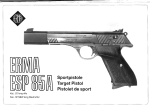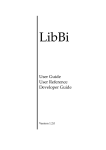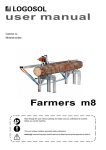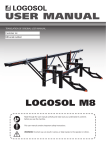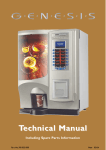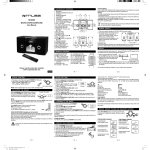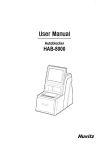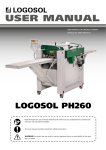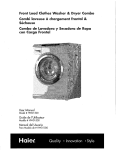Download Husqvarna M7 User's Manual
Transcript
Manual Read the safety instructions. Warranty Logosol offers a two-year warranty against material and manufacturing defects. The company will replace or fix any faulty parts or constructions within two years of purchase. Free technical support Regardless of where you bought our equipment, we offer free technical support by phone, fax, mail or e-mail. Regular information All users of Logosol equipment receive regular information about new products and accessories. Our homepage is also a source of up-to-date information. Those who haven’t ordered directly from Logosol. World service Everyone who bought directly from Logosol in Madison is already fully registered here. Those of you who bought the M7 through dealers must send in the warranty card below within thirty days of purchase in order to benefit from the warranty, get good service and receive the right spare parts. I have the following equipment: Sawmill M7 Woodworkers Mill Husqvarna 395 XP Log House Moulder Other: Other: Name: Address: Tel: Mobile: E-mail: Where bought: When bought: World Service P.O.Box 660 Madison MS 39130 Metric Parts Sizing Chart M6x30 Bolt 30 mm 0 10 Nut, Bolt and Washer Chart Sawmill Bolt Sizes M6 20 30 40 M8 50 60 M10 70 80 Metric scale in mm Collar nut Collar bolt Allen head bolt Total BAG 72-73 BAG 74 BAG 75 BAG 76 BAG 77 for Page 11 for Page 12 for Page 13-14 for page 15-17 for Page 18 8 8 8 4 3 64 24 18 8 7 2 Locking nut M10 Square nut M6 Nut M10 4 BAG 71 Collar nut M6 Locking nut M8 Note: You will also notice pages referenced on the bags themselves. DO NOT USE THE PAGE NUMBERS ON THE BAGS FOR REFERENCE. Only use the chart below to determine what bag is used for the assembly of which page. You will have extra nuts and bolts after the assembly of this mill. for Page 10 Collar nut M8 Locking nut M6 To assist you in the assembly of this mill, we have detailed the nuts, bolts and washers found on each page in the chart below. The part name and size is listed to the left and the total number found in the package listed in the second column. To the right, if a part is listed on a page in the manual, the number of that part to be used on that page is entered in the column for the page. Using this chart, you can lay out the parts for each page, and work your way through the assembly with your parts needed for each page. If you find you are missing any parts, please call our Toll-Free number and we will ship them out immediately to you. 10 2 1 1 18 6 2 Collar bolt M6x20 30 Collar bolt M6x40 8 8 4 8 4 2 16 14 8 Bolt M6x16 12 Bolt M6x20 12 Bolt M6x25 1 Bolt M6x40 6 Bolt M6x60 2 2 Bolt M10x40 2 2 Allen head bolt M6x25 4 4 Allen head bolt M6x30 4 4 Allen head bolt M8x14 2 Allen head bolt M8x25 8 Allen head bolt M8x30 8 Locking screw M6x8 6 6 Locking screw M6x10 4 4 M6 Washer 7 M8 Washer 8 M10 Washer 2 8 4 1 4 2 4 3 2 8 8 8 2 Preface Contents You are now the owner of a Logosol M7 WoodWorkers Mill, the result of our collective experience and dedicated efforts since 1988. There are currently more than fifteen thousand Logosol Sawmill in use in Sweden and the rest of the world, making the Logosol Portable sawmills the top seller world-wide. In closing, I wish you much enjoyment and success with your future Woodworking projects. The goal for Logosol’s development effort is to design smaller and lighter machines that solve a task intelligently, but without lowering the quality of the finished product. To top it off, Logosol products must be affordably priced so as to make them available to everyone working with wood. Design and construction of the M7 WoodWorkers Milll, plus manual text and pictures: Mattias Byström. Logosol produces a large range of products, enabling a single person to handle the entire production chain from forest felling to finished product. In addition to various sized sawmills, the range includes such products as a multisided planer providing exellent profiling. For more information on Logosol products and accessories, send for our catalog. Bengt-Olov Byström Precident Logosol As LOGOSOL is constantly developing and improving all machines and devices, we must reserve the right to change the design, technical characteristics and equipment of our machines. Printed on chlorine-free paper using vegetable-oil based ink. Manual, part. no.: 9999-000-9999 Copyright 2003 Logosol, Härnösand, Sweden Safety Rules Description Technical Specifications Assembly Tools Needed M7 Components 6 8 8 8 8 9 Assembly: frame Assembly: guide rail Assembly: cross beam Assembly: guide rail strut Assembly: log side-rest Assembly: log bed Assembly: saddle plate Assembly: rachet 10 11 11 11 12 12 13 13 Assembly: crank and lifting cable Assembly: edge support Assembly: carriage Assembly: chain guard Assembly: extender nuts Assembly: chain-saw Assembly: spiked log grip 14 14 15 16 16 17 18 Siting Adjustments – log bed Adjustments –guide bar Step-by-step Sawing Sawing Tips Material Drying Trouble-shooting Cutting Equipment Accessories Parts List EU Declaration 19 20 21 22 23 24 25 26 28 29 30 For us, the most important consideration is that you are 100% satisfied with your M7 WoodWorkers Mill. If you have any questions or thoughts about the sawmill, please do not hesitate to contact us. 5 Safety rules There are special safety rules to follow and dangers to be aware of when working with the Logosol M7 WoodWorkers Mill. This symbol points to dangers. However, since all risks are not marked, you must read the entire text. This symbol calls for additional attention to the text. Read through this whole manual carefully before using the M7. Failure to observe these safety instructions may result in fatal injury. Make sure that every person who uses the machine is well informed of the dangers and has read the entire manual. The manual must also be available to everyone using the sawmill. This is also necessary if the machine is sold or loaned out. Read the manual and safety rules for the particular sawing unit used on the M7. Minors under age 18 should not be allowed to operate the M7. Make sure that children and animals are kept at a safe distance. While the Logosol WoodWorkers Mill is a oneperson machine, be sure that there are other persons within hailing distance. The proper safety distance for persons 6 other than the operator is 8 m (26 feet) from all sides except where the logs are rolled in. The safety distance from this side is 15 m (50 feet), due to the danger of the chain being thrown out if it breaks. Always wear authorized personal protective clothing and equipment. Close-fitting working overalls are the appropriate garment – never wear loose items, worker’s jackets or the like. Anyone working with the Logosol M7 WoodWorkers Mill must be well-rested, healthy and in good physical condition. Take regular breaks while working and never operate the machine while under the influence of alcohol, other drugs or medicines that might cause drowsiness or in-attention. Do not wear a neckerchief, tie, jewellery or other items that can get caught in the equipment. Work only in when the light is good – never in darkness, fog or the like. Whenever you add extra equipment to the M7 sawmill, use products made by Logosol or specifically approved by Logosol for the purpose. Other equipment can cause accidents and thus should not be used. Logosol will not accept liability for personal injury or material damage incurred while using unauthorized attachments. Should a sawing unit weighing more than 15 kg (33 lbs) be used, support legs must be fitted under the guide rail ends in order to avoid tipping. Use safety shoes with high-grip soles and steel toecaps. Wear a safety helmet with hearing protection and a face shield. Remember that hearing can be damaged after relatively short exposure to the high frequency sounds from the motor and the cutting equipment. Protective goggles are also required as a face shield used alone will not provide sufficient protection for the eyes. Wear strong gloves. There is an injury risk whenever you handle the chain and the cutting equipment can be hot after sawing . Never reach over or under the guide rail during operation. The cutting equipment can cause severe injuries. When using a petrol-driven chain-saw: Fire danger – Turn the motor off before filling with petrol. Petrol is extremely flammable! Burns can cause death! If you spill any fuel, clean off any parts involved. If you get fuel on your clothing, change immediately. Close the tank lid as tightly as possible in order to reduce the risk of it coming loose due to vibrations during sawing. Never operate the chain-saw with the throttle lever locked. Always operate the throttle manually. Do not use a ripping chain for cross-cuts as this increases the danger of kickback. Before using the M7: Check the condition of the lifting lines especially carefully, replacing them at the slightest sign of wear. Check that all bolts and lock nuts on the log bed lifting unit and the locking system are tight and that all moving parts move freely. To avoid tipping, check that the M7 stands level and is well fastened in the bedding. To avoid chain breaks, check that the cutting equipment is correctly assembled. To avoid kickbacks when starting, check that the chain-saw is correctly positioned on the guide rail. Service: The M7 sawmill must be checked regularly and maintained as needed. Perform only the maintenance and repairs specified in the manual. Other repairs must be done by Logosol or by authorized Logosol dealers. Do not make any alterations in the construction of the sawmill as this can increase the accident risk. After service, the M7 sawmill should be returned to its original condition. Logosol accepts no liability for damage that occurs while working on an improperly modified machine. During operation: To avoid tipping, never place the machine at an angle while operating. The M7 should be fastened directly to the floor or be placed on a bedding of planks in order to increase the contact surface (follow the manual). Do not saw logs that are so short that they do not extend 0.2 m (app. 10 “) outside each log bed. A shorter log could fall when the log beds are raised. The overall max. load capacity of the M7 is 500 kg (1100 lbs). The 2.5 m extension increases the capacity by 250 kg (550 lbs) for each extension with a lifting unit. Always stand to the right of the chain-saw while it is operating. When a chain or band breaks, it is thrown out through the chip outlet. Keep the worksite free of tools, pieces of wood, chips and other items you can trip on. Turn the chain-saw off after each cut. Do not leave the M7 sawmill unattended where unauthorized persons might start it. Hold the crank firmly whenever raising or lowering a log. If released, the crank may spin back and hit your hand. Do not place your hand inside the long leg while raising or lowering the log. Should the lifting line snap or the crank spin, your hand may be caught. Logs must always be rolled on to the sawmill level with the horizontal beam. Do not lift logs from ground level directly onto the sawmill as this can cause injury if the machine tips or the log falls. ALWAYS REMEMBER that should any type of problem occur, stop sawing and turn off the chain-saw. Most accidents with dangerous machines happen when something goes wrong and the operator attempts to fix it while the machine is still running. A stop seldom shows up on the finished product. 7 Description - Because of the high quality and precision construction, none of the angles need setting. The only parts to adjust are the guide rail and the height of log bed, in all three bolts. - All aluminium components are anodized, creating a wearing surface as tough as tempered steel. It has a low friction coefficient and is easy to keep free of pitch and chips. - Adjustable legs make it easy to compensate for uneven sites. - The M7 has a double rachet mechanism enabling a simple shift by hand between 1/4” (6.25 mm) and 1/8” (3.12 mm) increments. - Clear scales show the height of the log bed. Extra measuring rods are available as accessories to show sawing height settings. - The knee joint on the front leg has a non-slip surface that facilitates log handling. The joint also has a mounting hole for ramps, log tables and the like. - The cross beam between the short legs is a significant stabilization factor. - The Logosol M7 WoodWorkers Mill will not rust. Springs are stainless steel and all steel parts are thoroughly galvanized. 8 Assembly - No maintenance is needed. The crank axle runs through maintenance-free bronze bearings, the slide rails use lowfriction plastic that has a working life of several years thanks to the superbly smooth surface anodization. - The settings for sawing parallel to the grain of conical logs are quick and simple. - All accessories for M7 sawmill fits the M7 WoodWorkers Mill as well. Technical specifications Length: 2.75 m (9 ft) Width: 1.25 m (4 ft) Width of log bed:0.5 m (1ft 8 in) Weightwithout saw:38.5 kg (85 lbs) Max. rec. log diam.: 0.6 m (2 ft) Max. rec. log length (standard design): 2.35 m (8 ft) Max.logweight: 500 kg (1 100 lbs) The M7 is designed for simple assembly and adjustment, mainly because there are fewer parts and assembly steps than were needed in earlier models. Most of the aluminium parts are anodized making it easier to force the bolts through the profile holes. Assemble the M7 on a surface that will not scratch the surface treatment. Save time by reading the entire assembly instruction before beginning to work. Then follow the instructions step by step. Whenever this symbol appears, tighten bolt loosely to allow some movement. When there is no symbol, tighten the bolts well. Tools needed (Tools are not supplied with delivery of the M7 WoodWorkers Mill.) 2 x 10 mm open end wrench 1 x 13 mm open end wrench 1 x 16 mm open end wrench 1 x 17 mm open end wrench Hexagon socket wrench/Allen key (metric) 1 x 4 mm open end wrench 1 x 8 mm open end wrench 1 x Try square Assembly will be facilitated with a battery-driven drill or screwdriver with a 10 mm hexagon socket and a ratchet key with 10 and 13 mm hexagon sockets. M7 WoodWorkers Mill components What follows is a brief description of the M7 components to assist in identifying them during assembly. A more complete listing is found at the end of the manual. 13 1 10 12 8 7 2 1 2 3 4 5 6 7 8 9 10 11 12 13 14 15 16 17 18 19 20 21 22 23 Guide rail Long leg Horizontal beam Short leg Cross beam Edge support 9 Log bed Guide rail strut Foot Log rest Knee joint Carriage Log grip Lifting beam Ratchet bar Ratchet bar stop plate Saddle plate Ratchet Cam Cam Axle Ratchet handle Ratchet neutral plate Turning spring Crank Lockring Lockring with line attachment Plastic slide rail on log bed Indicator Angle fitting Line pulleys 6 11 3 5 14 4 21 15 20 17 18 19 22 23 16 9 Assembly: frame A 2 1 3 4 4 The right and left leg units of the frame are assembled in the same way. The bolts listed below are for one leg unit. (1) Fit the horizontal beam to the short leg using the corner fitting. Be careful not to damage the bevelled faces before assembly. (4 x M6x20 bolts, 4 x M6 collar nuts) (2) Fit the horizontal beam to the long leg. The scale plate is fitted to the long leg using the two lower bolts. 10 Tighten all four bolts loosely to allow the beams to move somewhat in relation to each other. (4 x M6x20 collar bolts, 4 x M6 collar nuts) (3) Fit the angle fitting to the long leg and to the underside of the horizontal beam. First tighten the four bolts on the angle fitting loosely, gradually tightening them all the way. In this way the frame will be set at exactly 90°. (4 x M6x20 collar bolts, 4 x M6 collar nuts) Finally tighten the bolts between the horizontal beam and the long leg. (2) (4) Fit the sawmill feet, turning them so that the holes in the foot and the leg form a cross and that they lie correctly in the leg tracks. (4 x M8x25 allen head bolts, 4 x M8 nuts, 4 x M8 washers) (A) Assemble the pulley, see picture. (1x M6 collar nut) Assembly: guide rail, guide rail strut, cross beam B 6 5 C (5) Place the guide rail on the long legs, pressing the guide rail down while the bolts are tightened. (4 x M6x20 collar bolts, 4 x M6 collar nuts) Check that the angle between the guide rail and the long leg is 90°. 7 (6) Fit the strut to the inside (D) of the guide rail flanges with the oval hole up. (4 x M6x20 collar bolts, 4 x M6 collar nuts) (7) Fit the cross beam. In each leg there are six holes. The inner ones are used for the standard M7 unit (C), while the others are used when the M7 is extended and an additional cross beam is fitted on either side. (6 x M6x20 collar bolts, 6 x M6 square nuts) 11 Assembly: log side-rest (7) Fit the log side-rest. make sure that the measuring scales are both facing in torwards the center of the mill so that operator can read both scales from the center position.(2 x M6x20 bolts, 2 x M6 collar nuts) 7 (8) Place the plastic slide rail on the log bed. Fit the longer (A) scale against the plastic rail on the right log bed and the shorter (B) against the side of the left log bed. Do not tighten the bolts all the way. (2 x M6x30 allen head bolts, 2 x M6 collar nuts) (9) Fit the ratchet bar stop plate under the lifting beam. (2 x M6x25 allen head bolts) Assembly: log bed (10) Fit the line pulleys. (1 x M6x60 self-tapping bolt) Apply some pressure while driving it in. 8 A C 11 B 12 8 10 9 D 12 (11) Fit the log support on the lifting beam. As the bolts will be hard to screw through the holes, use an Allen wrench to pull the log support down to the lifting beam. After app. 20 hours of use, these bolts will need to be retightened. (4 x M8x30 self-tapping allen head bolts, 4 x M8 collar nuts) (C) Fit the bolt for extra support (M8x16 allen head bolt, 1xM8 collar nut) (12) Fit the rachet bar by threading the adjustment bolt (D) through the ratchet bar stop plate and screwing on the nut. Do not tighten. Place the bar in the track of the lifting beam and tighten the adjusting nut on the bar. (1 x M10x40 bolt, 1 x M10 nut) Assembly: saddle plate (13) Thread the lifting line through the hole in the lower part of the saddle plate and make the knot shown (A). Leave a 1 cm (3/8”) end after the knot. A (14) Press the steel sleeves into the holes in the plastic glides. Place the plastic glides (B) on each side of the lifting beam and fit the saddle plate over these. (4 x M6x40 collar bolts, 4 x M6 collar nuts) 14 B (15) The ends of the ratchet cam axle are different. Insert the one that has the recess nearest the tip through the lower hole in the long leg. 13 Assembly: rachet mechanism 15 16 B (16) Thread the short end of the spring through the scale selector’s spring holder and slip both over the cam axle inside the long leg. Now thread the axle through the first flange of the sadle plate. Thread the ratchet cam on in front of the opening in the sadle plate, placing an O-ring on both sides. Turn the axle so that the cam locking screw (M6x10) lines up with the recess. Screw the locking screw into the recess. Screw the cam axle handle locking screw (M6x10) in the other recess. Use protective gloves for the following steps (B): Pull the long end of the spring around to fasten it in the spring holder on the scale selector fitting. 13 Assembly: crank and lifting cable A (17) Thread the lifting line under the outside pulley on the lifting beam, straight up and around the pulley on the cross beam (A) and then down again to the inner pulley on the lifting beam. Fit the crank rod through the upper hole in the long leg and through the bushing on the middle flange. Place the lifting line in the locking collar recess. Thread the collar bushing with the line and the other collar bushing, on the crank rod.(collars facing out) Push the crank rod through until app. 1/8” extends beyond the outer saddle plate bushing. Screw the locking screw (M6x8)on the locking collars into the recesses on the crank rod. Then tighten the locking screw (M8x8) that’s holding the lifting line. 17 Assembly: edge support (18) Slide the edge support onto the log bed. 18 A 14 (A) Attach crank handle to the crank rod. Insert an allen wrench into the end of the threads on the handle and tight it with an m8 locking nut. Assembly: saw carriage 21 19 20 (19) Insert bolts through the holes along the sides of both the chain-saw bed (pylon) and the spool holder plate. Turn the square nuts a few times. (8x M6x16 bolts, 8 x M6 square nuts) (20) Insert the square nuts into the slide rail track, moving the spool holder plate and the chain-saw bed to opposite ends of the slide rails. Tighten the bolts. (21) Thread the line spool over the spool holder arm and tighten the nut. (1 x M10 locking nut) 15 Assembly: chain guard (22) Fit the chain guard on the support and bolt. (2 x M6x40 collar bolts, 2 x M6 locking nuts) 22 Assembly: extender nuts Remove the two bolts holding the guide bar and remove the guide bar cover. (23) Remove the bark grips, leaving the bolts and retightening the nuts. 23 24 16 (24) Refit the guide bar cover, replacing the guide bar bolts with the two extender nuts. The guide bar nuts will be used to fasten the chain-saw to the carriage. Only CE-approved chainsaws with two guide bar nuts may be used with the M7 sawmill. Assembly: chain-saw 26 25 (25) Fit the Logosol extender nuts through the chain-saw plate using the front hole. (For some chain-saw models the rear hole has to be used to ensure that the saw cover will not extend too far. However, this is relatively unusual.) Screw the chain-saw’s guide bar nuts onto the Logosol extender nuts under the plate and tighten. (26) Fit the chain guard support on the two arms of the chainsaw plate so that the chain guard sits app. 4 cm (1 1/2”) from the tip of the guide bar. (2 x M6x40 bolts, 2 x M6 collar nuts) (27) Push the assembled carriage onto the guide rail with the guide bar facing the log beds. Check that the carriage moves easily on the guide rail. If not, loosen the eight bolts holding the sliding rails, move the carriage back and forth and retighten the eight bolts. If this is insufficient, check the plastic slide rails for damage. 27 17 Assembly: spiked log grip with guard 31 32 28 29 30 29 30 (28) Screw the handle with a washer on the threaded rod for the log grip carriage. (1 x M6 washer) (29) Insert the bolts and screw on square nuts in the same way as when the chain-saw carriage was assembled (see page 17). (4 x M6x16 bolts, 4 x M6 square nuts) 18 (30) Fit the sliding rails under the plate so that the square nuts fit into the slide rail tracks. (31) Center the guard, log grip and plastic spacer over the holes in the plate. The spacer should be turned so it extends as far as possible behind the grip. Thread the bolts through the holes and tighten. (2 x M6x40 bolts, 2 x M6 washers, 2 x M6 nuts) (32) Thread the chain-saw feed line holder bolt through the spacer and fit on the plate. (1 x M6x25 bolt, 1 x M6 nut) The holder bolt can be fitted in one of two holes depending on whether a petrol or an electric saw is being used. The picture illustrates set-up for a petrol saw. Make a loop on the feed line and place it over the spacer. Siting M7 Min. 0.5 m (1.6 ft) The M7 WoodWorkers Mill may not tilt more than 5 ° from the horizontal in any direction. The saw may tip over if the tilt is greater. The unit may not be operated unless the feet are fastened to the floor. The carriage may slide off the guide rail if the tilt is greater. While the goal is to have the M7 WoodWorkers Mill fully level, any tilt, however slight, must not be away from the operator as this can cause the logs to slide off or lie at an angle. When setting up the M7 directly on the ground: The surface must firm and level enough that driving a normal car on it would not be a problem. Fit a board under each pair of legs using two M6 bolts for each foot. The boards must be of good quality, at least 50x150 mm (2”x 6”) and at least 2 m (6.5 ft) long. The boards must extend at least 0.5 m (1.5 ft) beyond the long legs. When bolting the M7 to a concrete floor, asphalt surface or similar, rigid surface, a rubber underlay should be placed under each foot in order to prevent vibration damage to the sawmill. Use a reliable fastening system between the feet and the surface. 19 Adjustments – log bed B D A C (A) Check that when the log bed is cranked down, it moves easily through the saddle plate driven by its own weight. If this is not the case: - Stop the log bed in the position that you judge to be the stickiest. If it is equally hard in all positions, place it in its uppermost position. Lock it using the rachet cam to prevent it from falling down. - Loosen the four bolts on the saddle plate and place it straight in relationship to the lifting beam. 20 - Loosen the plastic slide rail on the log bed (D) and adjust it so that it is straight in relation to the log bed track. - Lubricate the sliding surfaces and the T-track of the lifting beam using silicon or Teflon spray. (C) Use the bolt and inside nut on the rachet bar to move the log bed up until the setting block touches the underside of the guide bar. Should the adjustment be insufficient or too much, move the log bed up or down a notch and adjust again. Lock using the inside nut. (B) Check the height of the log bed. Set the rachet in the 1/4” position. Place the setting block on the log bed. Move the chainsaw guide bar to right over the log bed. Move the log bed up to the notch where the setting block is nearest to the underside of the guide bar. (D) To adjust the scale indicator, loosen the two bolts holding it and the plastic block on the log bed. Set both indicators of the scale to 2” in the position where the setting block touches the underside of the guide bar. Adjustments –guide bar A The guide bar should be parallel to the log bed. If this is not so, the guide bar is probably not straight. Remove the chain from the guide bar without removing the guide bar and move the sawing unit over the log bed. Use protective gloves! (A) Grasp the middle of the guide bar with both hands as shown and bend it carefully until it is parallel to the log bed. Check using the setting block. (B) How straight the guide bar mounts varies between chainsaws. It should only be necessary to adjust a guide bar once, provided that it is not bent during sawing. B If after turning the guide bar you notice that you need to bend it again in the same direction as before, it may be that the guide bar mount isn’t true. This can be compensated for by placing one or more adjustment pieces between the aluminium sliding rails and the chain-saw or electric saw plate. Adjustment pieces can be ordered from Logosol, part. no. 4507-0011305. 21 Step-by-step sawing instructions 1.1 Roll the log onto the log bed. 1 1.2 Fasten the log in place using the edge support. Place the edge support arms backwards and lock the block in place using the edge support side. 1.3 Set the rachet cam on either 1/4” or 1/8” increments using the rachet handle. The normal choice is the larger measurement. 2 1.4 Raise the stock so that a suitable slab size will be cut off. Normally the top end of the log is raised 1/4” or 1/2” (one or two clicks) above the bottom end so that the cut will parallel the grain. 1.5 Ram the spiked log grip into the butt end of the log to keep it from rotating. This should be done prior to each cut. 3 1.6. Place the saw feed line on the bolt with the spacer on the log grip carriage (not with electric feed). 1.7 For larger logs the log beds might be set at 7 1/4” or 8 1/4”, depending on whether a 1” or 2” board is wanted. 2.3 Cut the slab and perhaps one more board. 3.1 Rotate the cant 90° and fix with the edge support arms. Set the height so that a suitable slab is sawn. Now lay the top end somewhat higher than the bottom. 3.2 Raise both log beds the same distance while retaining the height differential. Saw out planks and boards until app. 10 cm (4”) remain. Do not forget to add 1/4” to each desired board thickness to compensate for the kerf. 4.1 Rotate the cant 180° and place both log beds at the same height. If a 1” and a 2” board are to be sawed out at the end, place the log beds at 3 1/4” (2+1+1/4). 4.2 Place the edge support arms backwards and lock the block in place using the edge support side. Otherwise you may saw into the arms. Cut the slab off. 4.3 4 1.8 On larger logs it is customary to raise the log bed to cut off another, wane-edged plank about 2 1/4” thick (nine clicks) to create a 2” plank. Don’t forget to knock out the log grip before raising the log beds. 2.1 Make the saw cut and then rotate the log 180°. 5 22 2.2 Should the log be small, the block size might now be set to 6”, for example. The log beds would be at the same height. Cut off the last slab. 4.4 Raise the log bed by 1 1/4” and saw the 1” board. What you have left is a 2” board. 5 Place the wane edged boards on their short end. Lock them in place with the edge support arm and trim the wane. As is usual, adjust the log bed height for the fact that one edge is still barked. When you turn the boards so that the side down is trimmed, set the log beds to the same height. Sawing tips Through sawing In the beginning it might serve you well to make a drawing on the top end of how you want to piece the log. Use a thick marker so that the line corresponds to the saw kerf. Remember that: When the log rests on a bark surface, the log bed at the top end is set higher than the one at the root end. When a sawn surface faces down, the log beds are set at the same height. At times it can be best to slice the log entirely into wane-edged boards. This way it is possible to get a bit more from each log. The price for the gain is that it takes a bit more time because of the need for after-trimming. If fine carpentry wood is the aim, it might be best to trim one side before drying. The last trim can be done when you know what the board will be used for – everything to allow maximum use of the wood. When you are going to slice a log beds, preventing movement between cuts and ensuring even boards. Turn the log when you approach the centre. Figure out the height where you should start and then saw. The example shown in the drawing calls for the first cut after the log is turned to be at 8 1/4”, calculated as follows: 1+1+1+1+1+2= 7. For each + add 1/4” to compensate for the kerf. The total is (5x 1/4) + 7 = 8 1/4”. In this way the final cut will be correct and you will have a minimum of wastage. Quarter sawing Compensate for the kerf with one click (1/4”) whenever the cut is above the guide bar. Do not compensate for the kerf when the cut is below the guide bar. The last board may not be thinner than 2”. Make sure you do not saw into the edge support spring arms. Many of us here at Logosol can share long sawing experiences. As a new Logosoloist, if you have any questions call us. We’ll be happy to provide you useful tips. log in this way it is best to saw off a thin slab first and then turn that side downwards. In this way the log will rest on an even surface on at least one of the Quarter sawing provides you with the finest material. You obtain optimal grain direction in all boards, something that is a great advantage for carpentry work and the like. The price is in time, in difficulty and in that you obtain several different width boards. Do not quarter saw small logs. Begin by halving andquartering the log. When sawing the boards out of the quarters, you turn the log 90° between each cut. Sometimes it is best to cut from below as this allows you to raise the log beds to the same height throughout. 23 Material drying Generally, once the wood is sawn it must be dried. It is possible to use undried wood in some construction, but only keeping in mind a 7% shrinkage in width and height. While most wood shrinks some 0.4% in length, this amount can usually be ignored. In order to avoid rot, you should not enclose undried wood in a way that makes it hard for air to circulate. One further tip is not to drive two nails into undried wood next to each other as the board will probably crack in the middle when it dries out. Drive one nail and wait with the second until the wood has dried. One example when you ought to use undried wood is building log structures. In such a situation, a heavy wall is a plus, as is the possibility that the logs still can be shaped when they are pressed against each other. 24 In most cases, however, the wood must be dried. If this is not done, there is a danger it will be damaged by dry or fungal rot. The best time for outdoor drying is in the spring. At that time the relative humidity in the air is comparably low meaning that the wood will dry quicker. Cut some supportive blocks (5x5”) in the length that corresponds to the width of your pile. Place these at regular intervals as shown below on dry, level ground free of growth. The spacing should not exceed 1 m (app. 1 yd) and should lie level and in line with each other. Cut spacers or drying sticks in the same length as the supportive blocks. They should be the same thickness (1x1” or 1x2”) and dry. You can get material for these by making an extra cut when trimming your boards. Place your first row of boards on the support logs, leaving about an inch between them. Then place a spacer on the boards above each support log. It is important to place the spacers exactly over each other to keep the boards from warping or bending. The higher you pile the boards, the better pressure there is on the lower boards. Place roofing or some material over the top, but leave the sides and ends open. Put a weight of some sort on top of the upper row to put pressure on those planks as well. If the wood is to be used for fine carpentry it ought to be stored in a heated facility several weeks before use or be dried in a kiln or other kind of wood drier. Trouble-shooting Reasons for wrong measurements on an M7 sawmill. A. Incorrect adjustment or set-up. B. Cutting equipment misfunction. C. Tensions in the wood. A. Checking the M7 1. Check that all four legs stand firmly and that the feet do not sink into the ground when a heavy log is loaded. 2. Sight over the log beds and cross beam to check that the sawmill stands straight. Check both loaded and unloaded. 3. Use a square to check very carefully that the guide rail is at an exact 90° angle to the long legs. Even a small deviation can lead to large measurement errors. 4. Set the distance between log bed and guide bar so that it is exactly the same to both log beds. Make sure the guide bar and the log beds are fully parallel. Use the setting block included with the machine. 5. Check that the guide rail is absolutely straight by sighting along the guide rail or by running a line over the guide rail and using nails or something similar as spacers between the line and the guide rail. 6. Check that the guide bar is straight in relation to the sawing direction by placing a 1.5 m (5 ft) strip of wood on the guide bar without the chain. Sight across the strip to make sure it is parallel to the guide rail. Even factory-new guide bar mounts can be out of true. This is discovered if the parallel relation to the log bed changes when the guide bar is turned. A bent guide bar is most easily straightened by being pressed up or down while the saw is mounted on the sawmill (see page 21). An out of true mount is corrected for by placing washers between the carriage plate and the slide rail. 7. The set-up of the M7 can be checked by placing a board with maximum length on the log beds. First trim off a narrow strip from one side of the board. Then turn it, set both log beds to the same height and remove a similar strip. Now measure the width of the board carefully. If the board is not the same width along its entire length it can mean that the log beds are incorrectly set or that the guide rail is crooked. It is also possible that the guide rail has been depressed by the weight of the log. When a heavy cutting unit is used, this problem can even occur if the support legs are not on a rigid surface. If a chainsaw is used the same thing can happen if you extend the guide rail more than 0.5 m (1.5 ft) without adding support legs. B. Checking the cutting equipment The guide bar must not cut upwards or downwards during sawing. This is most obvious when the guide bar leaves the log. If the guide bar does not simply float out of the log but springs up or down, problems can arise. In such cases there can be something wrong with the guide bar or the chain. Reasons for misfunction in the cutting equipment: 1. One frequent reason for problems when using the M7 is that the chain is dull (see page 26). 2. The chain may be damaged on one side, such as by metal objects in the log. The chain may still cut, but pulls up or down (see page 27). 3. The chain may have been filed wrong. The cutters may be filed less on one side than on the other. To get a more even result, try to maintain the same working position when filing the left and the right sides of the chain. That individual cutters are faulty or that some are missing, such as after sawing through nails, usually has very small effect on the function. 4. When precision diminishes after a period of fault-free sawing, it is almost always due to wear on the guide bar (see page 27). Continued on the page following. 25 Tensions in the wood can sometimes result in similar symptoms as faults in the cutting equipment. C. Tensions in the wood The M7 sawmill can only saw straight. If the wood grain twists during sawing, precision will be lost. Tension can cause large variations in measurement. Broad leaved trees have greater tension than do evergreens, but even the latter can have problematic tensions. One example is in trees that have grown on sharp inclines. In such cases a whole group of logs can be hard to saw. Tensions can also arise in storage. If the bark and top segment begin to dry, the whole surface will begin to shrink. In such a case, when one side is trimmed, the log may bend slightly. It is easy to discover tension in logs that leads to measurement errors. Each time you pull the saw back, you can read what is happening in the log. As long as the guide bar continues to lie just above the newly sawn surface, the log has not bent. However, if a spaces show up between the guide bar and the sawn surface or if the guide bar is pressed upwards, it is time to plan how the next cut will go to reduce the tensions. When sawing from the top towards the bottom, the wood has a tendency to sink at the ends pulled by its own weight. This is especially true if there is large root-end growth. If this is 26 true, then it would be best to turn the log after passing through the centre and saw the rest of the material from the other side. Some tips for avoiding the effects of wood tensions. 1. Cut wood with tension in as short lengths as possible. 2. Work around the log, sawing all sides in order. 3. Special arrangements may be needed in order to get a perfect measurement on the last board of a log. One effective way is to saw the last cuts using a recently sawn board as support. Demands on precision We are convinced that the M7 Wood Workers Mill provides as good or better results as other sawing methods. A large number of users of the Logosol sawmills have reported that they have never had better wood products than those they have sawn themselves with their Logosol mill. However, it is natural that we also meet customers who want to improve on the precision. By now we know that variations in sawing results can have many explanations. The choice of raw material is vital. Cutting good boards from short, sturdy logs is considerably easier than getting the same results with thin, long ones. Tensions caused by storage or place of growth can cause problems. Some tree types cause more problems than others. The reasons are many, including how much time is available. Sawyers with unlimited time have a greater chance to succeed than those whose time is short. The precision requirements also vary. A result that is satisfactory for someone sawing boards for rustic fence posts may not be good enough for someone sawing boards to be used in construction without being planed. If you have gone through the various steps for adjusting the M7 sawmill, checked the cutting equipment and observed the effects of tensions in the wood,but still do not get the sawing results you expect, contact us at Logosol. We have years of experience and can always help you find solutions to problems you may have. Cutting equipment The Logosol PMX chain provides for rapid ripping with a narrow kerf. But it is more sensitive than normal chains. Still, if you keep the cutting equipment in trim, you will get the right measurements, the sawing will be quicker and the cutting equipment will last longer. File before it slows down You will sense that the chain is loosing its edge by the fact that the sawing slows down, the guide bar gets hot and the feed is harder. Stop sawing at once! At this point it’s really too late to file. Sawing with a dull chain exposes the sawing equipment to great wear and tear. You must learn to file before the chain gets dull. File comfortably Both hand and electrical chain filing can give good results. The electrical is faster and simpler. For hand filing, we recommend a double file with a built-in filing gauge. (Pferd 4 mm, part. no. 9999-000-0400). It is much easier to sharpen the chain if you have a proper work place. Fasten the guide bar in a screw vice or a saw clamp. Best is to build a table next to the sawmill for filing and other chain-saw maintenance. If you have an electric saw, you will need a file block (part. no. 9999000-0620) to hold the chain during filing. Avoid chain breaks If you saw too long with a dull chain, it can break under the cutter where the material is worn. If, on the other hand, a drive link breaks the reason can be that the chain and the sprocket are not matched. For best results you should alternate five chains on one sprocket. When the chains are worn out, replace the entire set, including the sprocket. A new chain placed on a worn down sprocket can break during the first few minutes. It is not good to drive a normal 3/8” chain and a PMX chain with the same sprocket. The guide bar can pull askew If the chain has been damaged on one side or filed unevenly, the guide bar can steer askew. The guide bar will be pressed up or down or jumps when it leaves the log. This way the chain wears more on one bar rail and if you continue to saw, the guide bar will be worn lopsidedly. Even if you change the chain, a worn down guide bar can steer wrong and the new chain can be worn down. A lopsided guide bar can be fixed. File the bar rails until they are even, using a tool like a UKF file (part. no. 9999-000-0450). Another, more common reason that the guide bar pulls askew is that it is so worn out that the drive link bottoms in the bar groove and the chain looses its support from the guide bar walls. This can be seen on the chain in that the tip of the drive link becomes worn. The best chain oil In order for the chain oil to work well it must be viscous and thready. When you place a drop between the thumb and the index finger and then open them, long threads should form. Edge in the chromium layer The cutter on a chain-saw chain is covered with a very thin chromium layer, giving a very sharp and durable edge. As long as the edge is in the chromium layer, your chain will have perfect sharpness. However, after between 50 and 100 cuts with the M7, the edge in the chromium layer will be worn down. At that point it is time to file the chain. If you are really sensitive, you will notice that the chain slows up, the guide bar heats up and the feed pressure must be increased. If you file as soon as you sense that the chain is no longer perfectly sharp, you will need only a few, light pulls with the file. If you always file before the chain becomes dull, wear on the guide bar and chain will be minimal. However, if you make 5-10 cuts after the edge has left the chromium layer, the chain will be so dull it will be difficult to saw. The sawing speed will be low and the feed pressure high. The guide bar and chain will easily overheat. It is still possible to saw, but the equipment will wear out very quickly. When you file a chain, there is a real danger that you won’t reach the chromium layer. The chain may feel sharp, but because it isn’t in the chromium layer, it will become dull again very quickly. If you don’t file in time, you will have to remove a lot of the cutter to get it sharp. The working life of the chain will be short. And if a lot of the sawing is done with a dull chain, you will need a high feed pressure, with consequent rapid guide bar wear and a high risk for chain breaks. In conclusion, file before the chain is dull so that you avoid getting into a vicious circle where the wear on the sawing equipment increases and the sawing result goes down. Regular chain sharpening is especially important if you are sawing wood that is aggressive to the chain, such as dry material, hard wood or wood with sand or earth in the bark. 27 Accessories Logosol offers a great range of extensions, special tools and other accessories for the M7 Wood Workers Mill. Simple extensions can be bought in 0.5 lengths (1.6 ft). It is also possible to extend the Wood Workers mill to the M7Logosol Sawmill. The product catalog is available at no cost. Just order it. Cutting equipment Guide bar - 16” (40 cm), 1.3 picco Ripping chain for guide bar above, 60 DL Guide bar - 25” (63 cm), 1.3 picco Ripping chain for guide bar above, 84 DL To Stihl 064 / 066: Chain drive sprocket, picco To E 5000: Star drive, picco Part number 3003-000-6313 3961-000-0060 3003-000-5531 3961-000-0084 1122-640-2006 1207-642-1310 Filing equipment File block to hold the chain steady while filing Pferd file gauge, files cutter and drive link together 4 mm round file for Pferd file gauge 9999-000-0620 9999-000-0400 9999-000-0401 Extensions End extension 0.5 m (1.6 ft) M7 Sawmill upgade kit (9 ft) 4510-720-6602 4517-000-1020 Aids Measuring rod to check saw height setting Board shoe to fasten a 2x5” in the knee joint Log steps to load logs over 20” (50 cm), 2 items Edge support with spring-loaded arm Loading ramp to simplify control of saw on an M7 Accessory for rounding logs, saws 16 sides Adjustable log support, a universal tool Log roller, to move logs sideways Hearing protection with face shield Stainless steel knife, Logosol Folding rule 2 m, Logosol Cap, Logosol 4507-001-1300 4507-001-1304 4507-001-1302 4507-001-1025 9999-000-0920 9999-000-1100 4510-720-6202 9999-000-1420 0000-884-0503 9922-140-0000 9922-130-0000 9922-120-0000 Electrical sawing unit E 5000, high capacity 3-phase saw, incl. support leg Feed for E 5000, stepless in both directions 9999-011-0003 6600-000-1000 Moulders Electrical log molder, 3-phase Logosol SH230 planer, size and profile planing Logosol PH 260 4-side planer moulder 7600-000-0230 7200-000-0230 7502-000-0260 28 Article list 35-41 53 17 18 1 50, 51 43 4 2 9 7 44-47,52 48, 49 54, 55 8 10 3 This list includes items that are not part of the standard construction. The items are ordered one at a time. The number listed in the table indicates the number usually included. No. Article number 1. 2. 3. 4. 5. 6. 7. 8. 9. 10. 11. 12. 13. 14. 15. 16. 17. 18. 19. 20. 21. 22. 23. 24. 25. 26. 27. 28. 29. 30. 31. 32. 33. 34. 35. 36. 37. 4507-001-1000 4507-001-1015 4517-001-1009 4507-001-1030 4507-001-1035 4507-001-1040 4507-001-1200 4507-001-1045 4507-001-1050 4507-001-1025 4510-723-3900 4507-001-1190 4507-001-1165 4507-001-1170 4507-001-1055 4507-001-1060 4507-001-1075 4507-001-1070 4507-001-1065 4507-001-1080 4507-001-1085 4507-001-1090 4507-001-1095 4507-001-1101 4507-001-1105 4507-001-1106 4507-001-1150 4507-001-1115 4507-001-1120 4507-001-1125 4507-001-1130 4507-001-1020 4507-001-1185 4507-001-1205 4507-001-7600 4510-723-2905 4510-723-2511 # 2 2 1 2 2 4 2 2 2 2 6 2 2 2 2 2 2 4 2 2 2 4 8 2 2 2 2 2 2 2 4 2 2 2 1 2 1 5 6 12-14 28 29 32 Description Guide rail, 2.75 m (9 ft) Guide railstrut Cross beam Long leg Short leg Foot Horizontal beam Knee fitting Log bed Edge support Line pulley Setting block for log bed Short indicator Long indicator Rachet Cam Nuetral plate Angle fitting Log support Scale Lifting beam Lifting line, 2.05 m (6’9”) Saddle Plate, compl. Plastic slide rail, plate clamp Spacer Handle crank rod Stop ring, track Stop ring Rachet Axle Step chooser Turn spring Rachet Cam O-ring Rachet handle Rachet bar stop plate Line pulley holder Log grip, compl. Plastic slide rail, log grip * Spacer * 27 19 21-26 30 31 20 15 42 24 16 34 11 33 38. 39. 40. 41. 42. 43. 44. 45. 46. 47. 48. 49. 50. 51. 52. 53. 54. 55. 4510-723-4806 4510-723-5100 4510-723-4902 4510-723-4403 4507-001-1110 6600-000-1100 4510-723-2002 4510-723-6010 6600-001-2121 4510-723-3402 9999-000-1030 4510-723-2904 4510-723-4809 4510-720-3000 4510-720-2800 4510-720-2900 4510-723-3402 4507-001-1305 1 1 1 1 2 1 1 1 1 1 2 2 1 1 1 1 2 2 Log grip guard * Threaded rod * Adjustable handle, log grip * Log grip spikes 9-points * Rachet axle Carriage, complete Chain-saw feed line * Electric saw feed line * Line for electric feed 7mm* Line spool * Carriage slide rail, complete * Plastic slide rail, carriage * Chain guard * Chain guard mount * Spool holder * Pylon carriage plate * Logosol chainsaw nut Adjusting plate 0.5 mm * * Articles that are part of another article number, but can be ordered as a spare part or accessory. 29 EU Declaration Product: Manufacturer: Logosol M7 portable sawmill Logosol KB, Industrigatan 13 SE-871 53 Härnösand Tel. +46 (0)611 18285 The company hereby certifies that the Logosol M7 portable sawmill is manufactured in accord with the specifications in Machine Directive 89/392/EEC, as amended, and in accord with the following harmonised standard: EN 292. The M7 portable sawmill may only be used in combination with Logosol’s sawing units E 5000, E 3000 and BS 320 or with a chain-saw that satisfies the specifications in Machine Directive 89/ 392/EEC, as amended, and is fitted with two guide bar nuts for fastening to the carriage. In combination with an electric saw unit, the M7 portable sawmill satisfies the specifications in EMC Directive 89/336/EEC, as amended, and the low-tension directive 73/23/EEG. Härnösand 950101 Bengt-Olov Byström, Managing Director
































